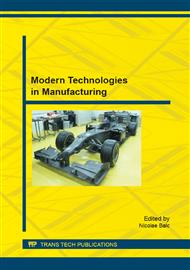p.80
p.86
p.92
p.98
p.107
p.113
p.119
p.125
p.131
Computer Aided Injection Multi Cavity Molding Process Analysis of Thermoplastic Polymers
Abstract:
Multi cavity injection molds contain two or more cavities for the fabrication of multiple parts in a single production cycle sharing a mutual batch of thermoplastic resins. The current study simulates the process of performing runner balancing for the two uneven cavities of an electrical box, while it studies the effects of certain injection molding process parameters. The runner layout and the injection locations have been studied and detailed considering the product’s geometries. The runner balancing procedure and the thickness distribution have been also investigated by taking into account the properties of three polymers such as high density polyethylene (HDPE), polystyrene (PS) and polypropylene (PP). The results show that the thickness distribution of the sprue and the runners for the PP and HDPE polymers is quite similar, after the conduction of the runner balancing process; on the contrary, the runners for the PS polymer should be thicker in order to achieve balanced filling within the cavities. The comparison of the materials reveals that PS has certain difficulties to flow under the conditions specified in this study. On the other hand, the injection of PP resulted in excellent balanced fillings, indicating a polymer that is easier to flow. Finally, the HDPE polymer appears to possess the greatest performance in terms of flowability considering the corresponding performances of PP and HDPE polymers.
Info:
Periodical:
Pages:
107-112
Citation:
Online since:
November 2015
Authors:
Price:
Сopyright:
© 2015 Trans Tech Publications Ltd. All Rights Reserved
Share:
Citation:


